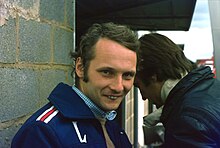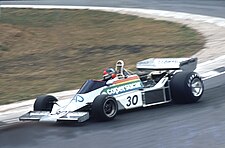1976 Formula One season
The controversy began in Spain where Hunt was initially disqualified from first place, handing the race win to Lauda, only for the decision to be overturned on appeal months later.
Lauda had a massive crash at the Nürburgring in West Germany and appeared likely to die from his injuries, but managed to return after missing just two races.
In the appalling weather conditions, Lauda withdrew from the race and Hunt finished third to take the championship trophy.
There had been no impactful regulation changes over the winter,[13] but before the 1976 Spanish Grand Prix, a restriction was placed on the height of the air box to no more than 850 mm (33 in).
Lauda thus started his title defence with victory, with Patrick Depailler second in the Tyrrell, and Tom Pryce completing the podium in the other Shadow.
It was Lauda who led into the first corner, with Hunt dropping down to fourth behind McLaren teammate Jochen Mass and Vittorio Brambilla in his March.
As the European season began at the Jarama circuit near Madrid, there was a big talking point as the Tyrrell team entered a new P34 six-wheeler for Depailler.
The Ferraris raced away, and Hunt dropped to sixth, behind Jacques Laffite's Ligier and the two six-wheeled Tyrrells, before eventually retiring with a transmission failure.
At one-third distance, Regazzoni went down an escape road because of oil on the track, and Peterson spun off and crashed on the next lap due to the same reason.
Scheckter took pole in Sweden at Anderstorp, the first for the Tyrrell P34, with Mario Andretti's Lotus second and Chris Amon an amazing 3rd on the grid in the Ensign.
The French round took place at the Paul Ricard circuit in the south of France, and 'normal service' was resumed, with Hunt on pole and Lauda second, with Depailler third, continuing Tyrrell's strong form.
In controversial circumstances McLaren, Ferrari and Ligier had Hunt, Regazzoni and Laffite all take part in the restarted race in spare cars.
The top three were unchanged till mid-race until Regazzoni retired with a gearbox problem, promoting Scheckter to third.
After the race, Ferrari, Tyrrell and the Fittipaldi team appealed against Hunt being allowed to take part in the spare car.
Ferrari took the matter to the FIA (which was hypocritical since their own driver, Regazzoni had started in a spare, although he retired), and two months later, Hunt was disqualified and Lauda was given the win.
Scheckter was promoted to second, Watson had another podium, and Two-time champion Emerson Fittipaldi got sixth place and a point.
On the second lap, Lauda lost control at high speed due to a suspected rear suspension failure and crashed into the barriers before bouncing back on to the track, and the car caught fire.
It took the one helicopter (which was parked at the pits on one extreme end of the circuit) at the track an excruciating 5 to 6 minutes to get to the accident site, and Lauda was sent to hospital with serious burns and was fighting for his life.
Hunt eased to victory ahead of Scheckter, and Mass completed the podium by passing Pace after Regazzoni spun off (again).
Scheckter battled until he crashed due to a suspension failure, and Peterson ultimately began to drop back.
Lauda had begun his recovery, and was planning to race later in the season, and as a result, Ferrari were back in business in the Netherlands, but with only one car for Regazzoni.
As the event went on at the modified Monza circuit, Laffite took pole in qualifying, with Scheckter's six-wheeler alongside and Pace third.
At the start, Scheckter led ahead of Laffite and Depailler with Lauda down in the midfield, but soon Peterson was on a charge and took the lead after 14 laps.
The week-long North American tour started with the teams assembling at the scenic Mosport Park track near Toronto for the Canadian Grand Prix.
But it was not for long as Hunt retook the lead on lap 10, and soon both Marches dropped way back, and so Depailler was second and Andretti third.
The penultimate round and the second leg of the North American tour was in the US at Watkins Glen, New York, a circuit similar (and close by) to Mosport Park in that it was fast and scenic with a number of long, sweeping corners.
The Marches were again unable to keep up the pace, and it was left to Lauda to take an astonishing podium, just beating Mass in the second McLaren.
Hunt led from Depailler and Andretti, but then began to suffer from tyre wear, and both drivers passed with 11 laps left.
Andretti won, getting his first win in five years, with Depailler second, and Hunt's third place meant that he was the F1 World Champion of 1976.
The 1976 World Championship of Drivers and the International Cup for Formula 1 Manufacturers were contested concurrently over a sixteen race series.









